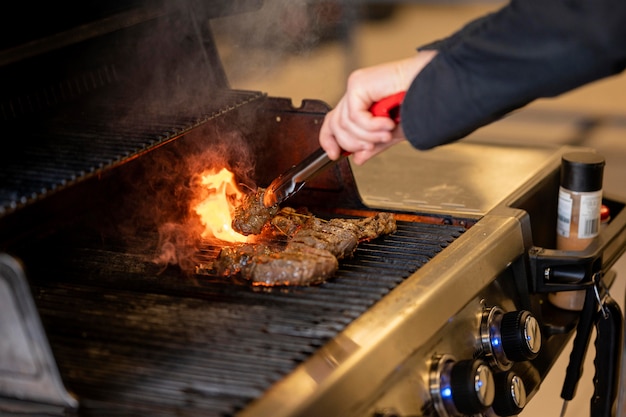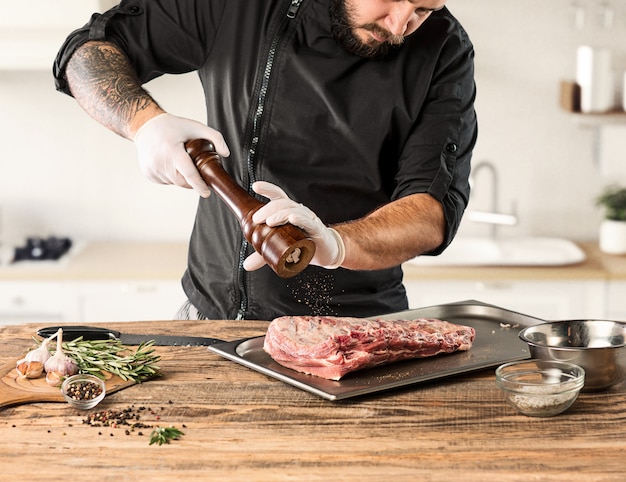There's something truly magical about a perfectly cooked steak. That beautiful, crispy sear, the tender, juicy interior, the aroma that fills your kitchen... it's pure culinary bliss. And the best part? You don't need a fancy grill to achieve this level of steak perfection. You can absolutely nail it on your humble stovetop. I'm here to share my years of experience, my hard-earned lessons, and my unwavering passion for a delicious steak. Let's get cooking!
Part 1: The Meat - Your Foundation for Success

choosing the right cut: A Steak Odyssey
It all starts with the meat, my friends. You want a cut that's not only flavorful but also naturally tender, with a good amount of marbling. Marbling is the fat that's interspersed within the muscle, and it's crucial for juicy, tender steak. Think of it like the secret ingredient to a succulent, flavourful experience.
Now, when it comes to choosing the right cut, I’m a firm believer in going for a ribeye. Its rich marbling, the beautiful, well-defined eye of fat at the centre - it's just irresistible. But let's be honest, everyone has their personal preferences. Maybe you're a new york strip aficionado, or a sirloin devotee. Whatever your choice, make sure you’re getting a steak that's at least an inch thick, preferably closer to 1.5 inches. This thicker cut holds its heat better, ensuring even cooking and a beautifully juicy result.
The Power of Thickness: A Cooking Advantage
Why the obsession with thickness? Well, imagine a thin steak on a blazing hot pan. It cooks fast, but the heat sears the exterior before the inside has a chance to cook evenly. It’s like trying to bake a cake in a super hot oven – it'll be burned on the outside and raw in the middle. But with a thicker steak, that heat penetrates gradually, giving the centre time to reach the perfect level of doneness. And that's how you achieve that coveted balance of tenderness and flavour.
Prepping the Steak: Setting the Stage
Once you've got your chosen cut, it's time for a quick prep. Pat it dry with some kitchen paper – we want that surface nice and dry for a sizzling, crisp sear. Now, here's a little secret for extra flavour: generously season it with salt and pepper. Don't be shy with the salt! It draws moisture from the meat, creating a more flavorful, tender texture. Plus, it helps form a beautiful, crispy crust.
Part 2: Your Arsenal - The Tools that Make the Difference

The Cast Iron Hero: A Culinary Workhorse
Okay, let’s talk about the pan. It’s not just any pan; it's a key player in the steak game. You want something that heats up evenly and retains heat beautifully – a cast iron pan is your best friend in this situation. These pans are practically indestructible, they get incredibly hot, and they bring that amazing, crispy sear to your steak.
If you've never used a cast iron pan before, I highly recommend giving it a try. It's a bit of an investment, but it's a worthwhile one. Just be sure to season it properly (a quick Google search will show you how) and you'll be rewarded with years of delicious, perfectly seared dishes.
The meat thermometer: Your Steak's Faithful Companion
Now, no steak enthusiast should be without a meat thermometer. It’s not just a fancy gadget, it's your safety net, your way to ensure you're getting that steak cooked to your exact preference. No more guessing, no more hoping for the best. With a thermometer, you can be confident that your steak is cooked perfectly, every time.
Part 3: The Heat is On! - Setting the Stage for Success

Searing Heat: The Key to a Perfect Crust
Get that cast iron pan blazing hot. We're talking scorching, smoking hot. If you have a gas stove, you'll want to turn it up to high heat. Electric stovetop users, let it reach its maximum temperature. You want to hear that sizzle, that satisfying crackle when you lay the steak down. That’s the sound of magic in the making.
Adding Oil: Lubricating the Magic
Once the pan is smoking hot, add a tablespoon or two of oil. It's best to choose an oil with a high smoke point, like grapeseed oil or avocado oil. They'll stand up to that intense heat without burning or producing harmful smoke. Let the oil heat up and shimmer before you add your steak.
Part 4: The Art of the Sear - Mastering the Golden Crust
First Impressions Matter: The Sizzle that Seals the Deal
This is the moment we've been waiting for. Carefully place your steak in the hot pan and resist the urge to move it around. Let it cook undisturbed for 3-4 minutes per side. You're aiming for that beautiful, golden brown crust, a crispy barrier that locks in all that juicy flavor.
Remember, patience is key. Don’t rush the process. Let the steak do its thing. It'll create its own delicious symphony of sizzling sounds and fragrant aromas.
The Flip: A Moment of Culinary Drama
After those precious 3-4 minutes, it's time for the flip. Turn your steak over with a pair of tongs and let it cook for another 3-4 minutes. Keep an eye on it - that golden brown crust should be developing nicely on the other side.
The Resting Period: Releasing the Flavor Prison
Once your steak is cooked to your liking (we'll get to doneness in a minute), remove it from the pan and let it rest for 5-10 minutes before slicing and serving. This is crucial. Think of it as a little decompression chamber for your steak. The resting period allows the juices to redistribute throughout the meat, resulting in a much more tender and flavorful steak.
Part 5: Doneness Decoded: Understanding Your Steak's Journey
The Doneness Chart: Navigating the Steak Spectrum
Now, let's talk about doneness, the holy grail of steak cooking. Everyone has their personal preference, but it’s good to have a basic understanding of what’s happening as the steak cooks. Here’s a handy chart that breaks it down:
| Doneness | internal temperature (°F) | Internal Temperature (°C) | Description |
|---|---|---|---|
| Rare | 125-130 | 52-54 | Red center, cool to the touch |
| Medium-Rare | 130-135 | 54-57 | Slightly pink center, warm to the touch |
| Medium | 135-140 | 57-60 | Pink throughout, hot to the touch |
| Medium-Well | 140-145 | 60-63 | Very little pink, very hot to the touch |
| Well-Done | 145 | 63 | No pink, very hot to the touch |
Use your trusty meat thermometer to check the internal temperature and ensure it matches your desired doneness. Don't worry about being a stickler for precise temperatures – it's more about getting a general sense of how cooked you want your steak. And remember, it's perfectly acceptable to adjust cooking times to suit your personal taste.
Part 6: Finishing Touches: Elevate Your Steak to New Heights
Butter, Butter, Butter: The Symphony of Flavor
For an extra touch of indulgence, consider adding a knob of butter to your resting steak. Place the butter in the pan with some fresh herbs like thyme or rosemary. As the butter melts, it will infuse your steak with a rich, aromatic flavour. It's a simple step that makes a world of difference.
Sides and Sauces: The Perfect Companions
No steak is complete without some delicious sides to round out the experience. Think roasted vegetables with their charred edges and bursting flavors, creamy mashed potatoes, or a crisp, refreshing salad. And don't forget a sauce! A robust red wine sauce or a creamy béarnaise can elevate your steak to new heights of deliciousness.
Part 7: The Mistakes I've Made: Lessons Learned in the Kitchen
Don't be afraid to make mistakes! Even seasoned cooks like me have had our share of mishaps. Here are a few of the mistakes I've learned from over the years:
- Not letting the pan get hot enough: This results in a pale, greasy steak that lacks the perfect sear.
- Crowding the pan: This can lead to uneven cooking and steamed, rather than seared, meat. Give your steak some space to breathe!
- Not letting the steak rest: A rushed steak is a dry, chewy steak. Let those juices redistribute and work their magic.
- Over-seasoning: Sometimes less is more. You don't want to overwhelm the natural flavour of the steak.
Remember, every mistake is a learning opportunity. Don't be discouraged! Just keep practicing, and you'll be a master of stovetop steak in no time.
Part 8: FAQs: Answering Your Steak-Related Questions
1. What if my steak is too thin?
Don't fret! Even a thin steak can be delicious. Just cook it for a shorter time, about 2-3 minutes per side. You might also want to use a slightly lower heat to avoid overcooking.
2. How do I know when my steak is done?
A meat thermometer is your best friend. But if you're going without, you can use the touch test. Gently press the center of the steak. Here's a guide:
- Well-done: Firm and springy to the touch
- Medium-well: Slightly soft and bouncy
- Medium: Soft and squishy
- Rare: Very soft and almost jiggly
Remember, this method is not as accurate as a thermometer, but it can be helpful in a pinch.
3. Can I use a different type of pan?
Absolutely! While cast iron is ideal for searing, you can use a heavy-bottomed pan that heats evenly. Just make sure it reaches that high heat for that perfect sear.
4. What if I don't have a meat thermometer?
You can use the touch test, or try the "finger test" method. Press your finger into your palm. The firmness of your palm should be similar to your desired doneness:
- Rare: Like pressing your finger on your thumb
- Medium-rare: Like pressing your finger on your index finger
- Medium: Like pressing your finger on your middle finger
- Medium-well: Like pressing your finger on your ring finger
- Well-done: Like pressing your finger on your pinky
Again, this method is not as accurate as a thermometer, but it can be a useful guide.
5. What are some good sauces to serve with steak?
The world is your oyster! Here are a few classics to get you started:
- Red wine sauce: Bold and full of flavour, it's a perfect match for a juicy steak.
- Béarnaise sauce: Rich, creamy, and tangy, it elevates any steak to a luxurious level.
- Peppercorn sauce: A punchy, peppery sauce that adds a kick to your meal.
- Garlic butter sauce: Simple, elegant, and bursting with garlicky goodness.
- Mushroom sauce: A rich, earthy sauce that's perfect for steak lovers who appreciate a touch of umami.
I hope this guide has given you the confidence to tackle stovetop steak with ease. Now, go forth and conquer the kitchen! Enjoy the journey and let your culinary creativity shine. Happy cooking!
Everyone is watching

Corn on the Cob: The Ultimate Guide to Perfectly Cooked Ears
Healthy MealsAh, corn on the cob. Just the name evokes images of sunny days, barbecues, and that sweet, juicy flavour that ...

Perfect Pork Roast Oven Cooking Time: A Guide to Delicious Results
Healthy MealsThere's something truly satisfying about a perfectly roasted pork. The aroma alone is enough to make your mout...

Ham Cooking Time: How Long to Bake, Smoke, or Boil a Delicious Ham
Healthy MealsAh, ham. It's a classic, isn't it? A real crowd-pleaser, especially around holidays. And when done right, it'...

Scallops: The Ultimate Guide to Perfect Cooking
Healthy MealsAh, scallops. Those delicate, sweet, and utterly delicious morsels of the sea. They hold a special place in my...

Spaghetti Squash: The Ultimate Guide to Cooking and Serving
Healthy MealsRemember that time you saw spaghetti squash at the supermarket, looking all bumpy and strange, and thought, "W...
